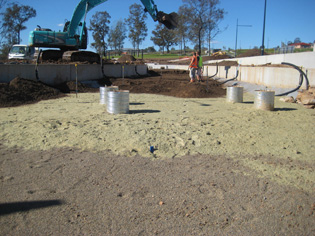FILTERING OUR FUTURE
19 Nov 2014, 710 views
Find out why the Benedict Bio-retention Filter Media (M165) has been considered the industry benchmark for many years.

Over the last 10 years, the majority of new developments have utilised Bio-retention Systems as part of the Water Sensitive Urban Design (WSUD) initiative.




Storm water captured in a Bio-retention Basin is controlled and treated by forcing it to slowly percolate through an engineered Filter Media, and then pass through the Transition Layer and finally the Gravel Layer.
These Bio-retention basins are also a valuable aesthetic, and at times recreational asset in new residential estates, and as a result have been a very welcome addition to the landscape.
Benedict Bio-retention Filter Media, M165, has been considered the industry benchmark for Bio-retention Media supply for many years. Its proven Hydraulic Conductivity combined with high plant strike rate addresses both the engineering and horticultural requirements for a successful Bio-retention filter media.
Developed to FAWB (2009) Guidelines, and in consultation with J. Wyndham Prince Engineers, M165 has been well accepted in the marketplace.
Peter Mehl from J. Wyndham Prince says:
“M165 has been specified on a significant number of Bio-retention systems servicing urban development projects in Western Sydney since 2007. It seems to strike an ideal balance between maintaining excellent hydraulic conductivity over time and sustaining vigorous media bed vegetation growth and consequently it has been our media of choice for these systems.”
The Filter Media (M165), Transition Layer (GTRANS) and Drainage Layer (5CRG) have been specifically engineered to work together to give a free draining, horticultural soil profile - click here for an illustration.
All materials are externally tested through SESL for hydraulic conductivity and compliance to FAWB specification, and have been selected with consideration for their bridging properties to assure particle migration does not happen between layers (avoiding fine particles blocking the drainage layer and restricting water movement into the agg line). Where possible, we have also utilised sustainable, recycled materials in our Bio-retention Profile. Our Transition Layer (GTRANS) is made from 100% Washed GlassSandTM.







